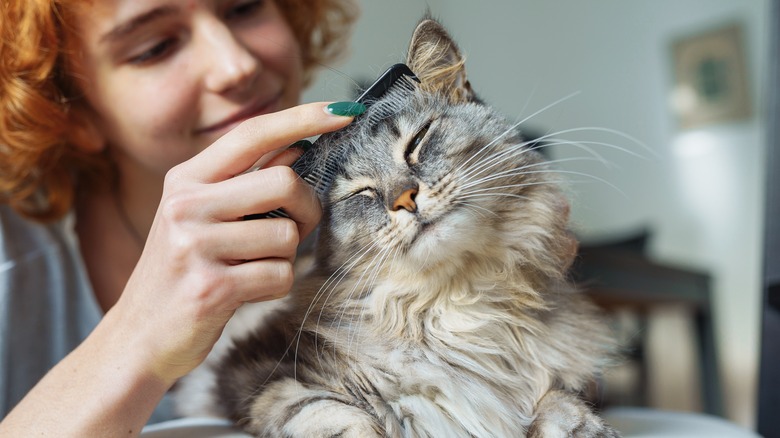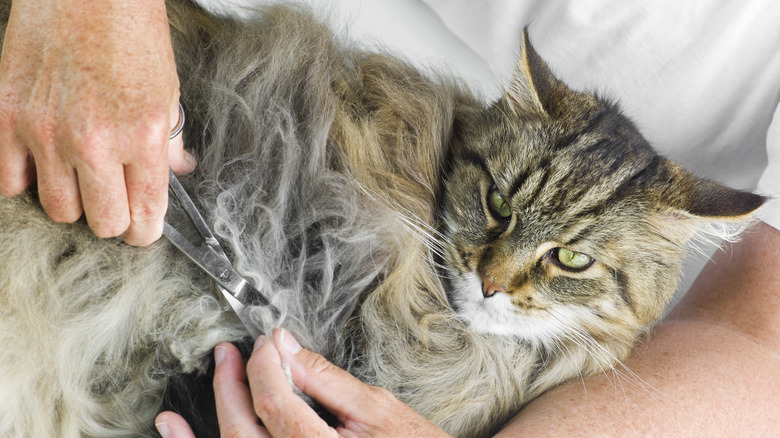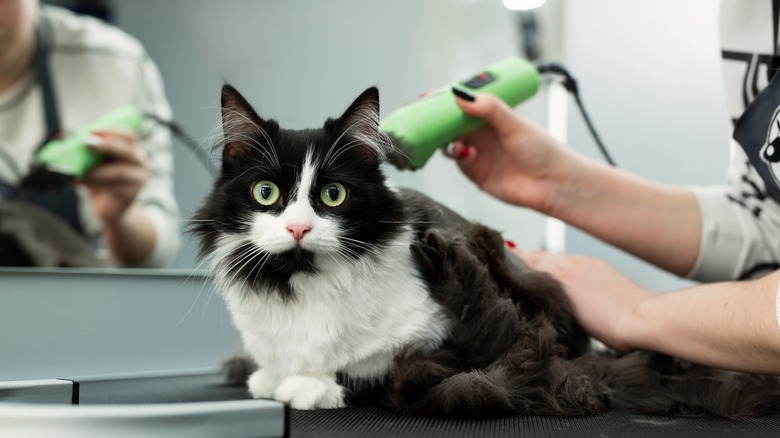How Often Should You Groom Your Cat? It's All In The Hair Type
It's commonly known that cats groom themselves (even right after you pet them), so you might not think that you have to do much in that department. Unfortunately, this is a misconception. Cats lick themselves a lot, but many simply can't self-groom to the extent they need to in order to maintain a healthy coat. How often you should groom your feline companion depends on several factors, including "their coat type, breed, age, and physical ability to groom themselves," Dr. Holly Anne Hills shared on Cats.com.
In general, long-haired breeds are going to require more brushing than short-haired breeds. Ideally, daily brushing is recommended for medium- or long-haired cats, while you can usually get away with brushing those with short hair once a week. And while brushing is usually adequate to keep a short or medium coat in good condition, your long-haired cat should also get a bath around four times a year, Dr. Hills explained.
Grooming for short-haired cats vs. medium- or long-haired cats
If your cat is a short-haired cutie, make brushing a weekly habit. A metal comb is a great tool to use as a first step — it will pull up dead hair and hopefully make your kitty nice and relaxed. After you've loosened up the hair, go back over their coat with a rubber brush or a soft-bristled brush. Make sure you start at their head and brush toward their tail in the direction of the fur. That two-step process is usually all a short-haired cat will need, as long as you do it about every seven days.
Medium- and long-haired cats require more in-depth grooming. A daily session with a wide-toothed comb is the way to start. If you encounter any mats, there are special removal tools or trimmers you can use to get rid of them. Next, use a fine tooth comb followed by a soft-bristled brush or a glove brush, which can remove any last pesky hairs. With long-haired cats, it's best to start at their legs and their belly and gradually move up from there. It's also useful to brush the hair up from the skin in order to make sure you catch all tangles and mats and thoroughly clean the hair. And don't forget your kitty's tail! Part the hair down the middle and brush each side for a complete transformation.
While it's important to groom your cat, it's equally important not to overdo it. Signs of over-brushing include irritated skin, pulling out hairs that were still attached, and your cat expressing that they're in pain. Felines have thin skin, so grooming sessions should be gentle and occur only as often as needed.
Why regular grooming matters
Some cats aren't quite cooperative when it comes to being brushed and bathed, so you may be asking yourself if regular grooming is actually necessary. The answer is yes. Grooming removes dirt and, importantly, dead hair from your cat's coat, which stops matting and tangles before they start. Mats are important to prevent because they can cause skin issues like dryness or soreness if they're allowed to form.
Brushing your kitty's hair also makes you pay extra close attention to the state of their fur and skin, which is important for recognizing health issues that can crop up, from dry skin to differences in their weight. Grooming your cat also reduces the risk of hairballs and provides bonding time for you and your kitty. Ideally, brushing your cat is a relaxing and positive experience for both of you, but it may take some trial and error.
If your medium- or long-haired cat needs a bath or a brush or you need to clip your kitty's nails but they really won't let you near them, professional grooming is the way to go. Sarah Thomas, Certified Feline Master Groomer at Wil-O-Paw Animal Hospital in Coloma, Michigan, told Chewy, "If your cat is being groomed professionally every 4-8 weeks, then very little brushing is required at home. Some still benefit from a weekly 5-10 minute comb-out while on a monthly grooming schedule."


